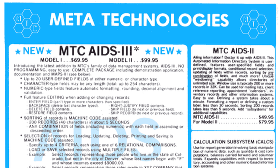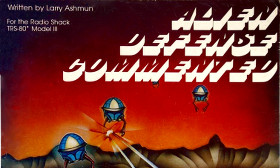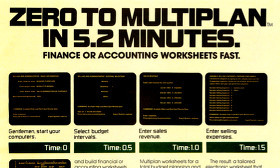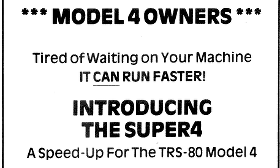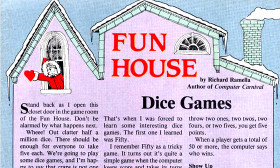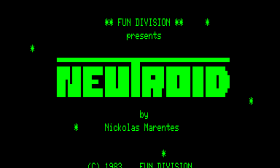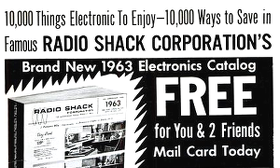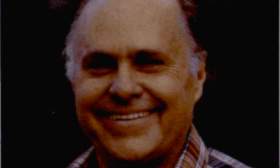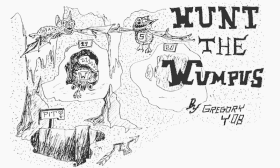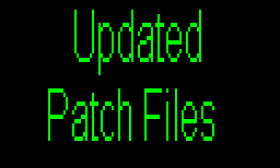AIDS-III, also known as MTC AIDS-III, was a very popular database system for the TRS-80 Model I, III, and II. Its unfortunate name (in retrospect) stood for Automated Information Directory System. AIDS-III was a highly regarded program and final member of the family of AIDS products.
Robert Fiorelli, the primary author of AIDS-III, described it not as a “database management system” but as a “data-management system”:
AIDS-III is a data-management system. This is different from a data-base management system. The former is generally faster, more flexible, and is suited for selecting and ordering information in a highly dynamic fashion. By contrast, the latter has higher capacity, is slower and more cumbersome, and is suited for easily accessing individual items of data. Think of it as the difference between driving a station wagon and a bus.
(Read more...)
Alien Defense Commented is an unusual book that contains the complete source code listing for the Soft Sector Marketing game Alien Defense (which was still being sold at the time the book was published). It was written by Larry Ashmun, the author of Alien Defense, and was intended for programmers looking for “details of one approach to game writing.” As the advertisements promised:
Never Before Has Anyone Sold a Book Like This!
If you write in machine language; if you have thought of writing a machine language game; if you ever just wondered what a machine language program looked like in its uncompiled form – this is your book!
(Read more...)
Microsoft Multiplan was an early spreadsheet program and the first piece of application software from Microsoft to target end users. It was introduced in 1982 with versions for CP/M, MS-DOS, and the Apple II. Versions for many other computers, including various TRS-80 models, soon followed. Multiplan was the first (and for a while the only) third-party software package available when the Apple Macintosh was introduced in 1984.
Multiplan (sometimes called the Multiplan Electronic Worksheet) was a “second generation” spreadsheet, designed to compete with VisiCalc, the original (and incredibly popular) spreadsheet program. Multiplan was written by Douglas Klunder under the direction of Charles Simonyi, the head of Microsoft’s new application software group.
(Read more...)
The Super4 was a popular speed-up board for the TRS-80 Model 4. Introduced in 1984 by Alpha Technology, Inc. (not to be confused with Alpha Products), the Super4 was both inexpensive and easy to install. As the advertisements stated, it required “No trace cutting. No soldering. No wires to connect.”
The Super4 package contained everything necessary for the speed-up, including a faster Z80 chip. Installation consisted of unplugging the 4 MHz Z80 CPU from the Model 4 and plugging the Super4 into the now empty Z80 socket.
(Read more...)
“Fun House” was one of the best remembered columns that ran in 80 Micro magazine. It was written by Richard Ramella, author of the 1982 book Computer Carnival: Sixty Programs for Starters". “Fun House” first appeared in the September 1982 issue of 80 Micro and ran until April 1984, with one gap for the February 1984 issue.
Computers were still a scary unknown for many at the time and “Fun House” encouraged people to have fun with computers. Ramella used his gentle style to focus on a different theme each month:
(Read more...)
Neutroid was written by Nickolas Marentes in 1983 and sold through his company, Fun Division (known earlier as Supersoft Software). It was the third of seven games that he wrote for the TRS–80 Model I and Model III. Nickolas Marentes became better known for his later TRS–80 Color Computer games such as Donut Dilemma (which began with a Model I version) and Rupert Rythym.
Marentes was inspired to write Neutroid after reading an interview with Tim Skelly, the author of the 1982 Gottlieb arcade game Reactor. Although Neutroid doesn’t resemble Reactor in any way, they both share a similar abstract concept of manipulating particles within an enclosed space to prevent a nuclear disaster.
(Read more...)
News organizations are reporting that the stock of RadioShack (formerly known as Radio Shack) will soon be delisted from the New York Stock Exchange. Everyone seems to expect that bankruptcy will be the next step. Although it’s still possible that someone will step forward to keep the company going after the bankruptcy, it’s more likely that the stores and brand will soon be shut down.
This is hardly surprising, but sad nonetheless. Even though Radio Shack hasn’t sold its own computers since 1993, it was still a direct link back to the TRS-80. Radio Shack’s demise will leave only Apple as the last remaining company responsible for the “1977 trinity” (as BYTE put it in 1995) of the Radio Shack TRS-80, Apple II, and the Commodore PET.
(Read more...)
I was saddened to learn that Wayne Green died on September 13, 2013. Longtime TRS-80 enthusiasts will remember Wayne Green as the founder and publisher of 80 Micro, the most famous and best remembered TRS-80 magazine.
Wayne Green had a long history in publishing. He began his first newsletter, Amateur Radio Frontiers, in 1951, reflecting his lifelong interest in amateur radio (his callsign was W2NSD). He became editor of CQ, an amateur radio magazine, in 1955. He started his own amateur radio magazine, 73 (also called 73 Amateur Radio Today), in 1960. 73 was his longest running magazine, continuing until 2003.
(Read more...)
Hunt the Wumpus, also known as
Wumpus 1 or simply
Wumpus, was an important early computer game. It was written by Gregory Yob in either 1972 or 1973.
Hunt the Wumpus was one of the first games to allow the player to move around a series of interconnected rooms. Although not an adventure game itself, it influenced the text adventure games that followed.'
(Read more...)
Garry Howarth recently discovered a bug in my LS-DOS 2012 date extension patches. He found a particular disk that would crash the DIR command after installing the date extension patches.
As it turned out, displaying a directory of a disk containing a large file with directory extents on different sectors could sometimes overwrite the patch code, leading to a crash. I needed to rearrange the DIR patch code to avoid this potential problem. This required a new version of the LS-DOS date extension patches.
(Read more...)
